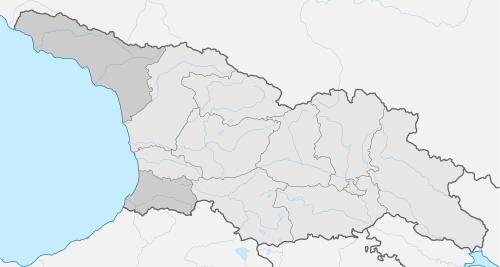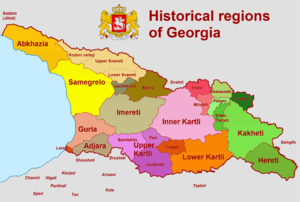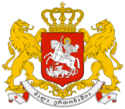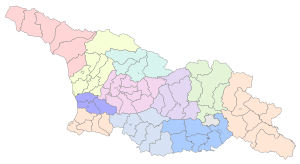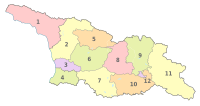التقسيمات الادارية في جورجيا
| جمهوريات ذاتية ومناطق وبلديات | |
|---|---|
| التصنيف | Unitary state |
| الموقع | جورجيا |
| العدد | 9 مناطق 2 جمهوريتين ذاتيتين 76 بلدية |
| عدد السكان | (المناطق فقط): 51,000 (Racha-Lechkhumi and Kvemo Svaneti) – 511,300 (Kvemo Kartli) |
| المساحة | (المناطق فقط): 2،030 km2 (785 sq mi) (گوريا) – 11،380 km2 (4،393 sq mi) (كاختي) |
| الحكومة | مجالس بلدية، حكومات جمهوريات ذاتية، الحكومة الوطنية |
| مناطق جورجيا | ||
|---|---|---|
| Map ref. | Region | Capital |
| 1 | Abkhazia | Sukhumi (Sokhumi) |
| 2 | Samegrelo-Zemo Svaneti | Zugdidi |
| 3 | Guria | Ozurgeti |
| 4 | Adjara | Batumi |
| 5 | Racha-Lechkhumi and Kvemo Svaneti |
Ambrolauri |
| 6 | Imereti | Kutaisi |
| 7 | Samtskhe-Javakheti | Akhaltsikhe |
| 8 | Shida Kartli | Gori |
| 9 | Mtskheta-Mtianeti | Mtskheta |
| 10 | Kvemo Kartli | Rustavi |
| 11 | Kakheti | Telavi |
| 12 | Tbilisi | Tbilisi |
تقسيمات جورجيا هي جمهوريات ذاتية (بالجورجية: ავტონომიური რესპუბლიკა, avtonomiuri respublika)، ومناطق (მხარე, مخارى)، و بلديات (მუნიციპალიტეტი, munits'ipaliteti).
Georgia a unitary state, whose borders are defined by the law as corresponding to the situation of 21 December 1991. It includes two autonomous republics (بالجورجية: ავტონომიური რესპუბლიკა, avtonomiuri respublika), those of Adjara and Abkhazia, the latter being outside Georgia's effective control. The former, Soviet-era autonomous entity of South Ossetia, also not currently under Georgia's de facto jurisdiction, has no final defined constitutional status in Georgia's territorial arrangement.[1]
The territory of Georgia is currently subdivided into a total of 76 municipalities—12 self-governing cities (ქალაქი, k'alak'i), including the nation's capital of Tbilisi, and 64 communities (თემი, t'emi). The municipalities outside the two autonomous republics and Tbilisi are grouped, on a provisional basis, into nine regions (mkhare): Guria, Imereti, Kakheti, Kvemo Kartli, Mtskheta-Mtianeti, Racha-Lechkhumi and Kvemo Svaneti, Samegrelo-Zemo Svaneti, Samtskhe-Javakheti, and Shida Kartli. Tbilisi itself is divided into ten districts (რაიონი, raioni).[1]
الجمهوريات الذاتية
The two autonomous republics, Abkhazia and Adjara, were established during the Soviet era and are recognized by the modern Constitution of Georgia adopted in 1995.[1]
أجارا
Adjara is subdivided into 6 municipalities:
- The self-governing city of Batumi, which is the entity's capital;
- The self-governing community of Keda;
- The self-governing community of Kobuleti;
- The self-governing community of Khelvachauri;
- The self-governing community of Shuakhevi;
- The self-governing community of Khulo.
أبخازيا
As a result of the military conflicts in 1992–1993 and 2008, Georgia has no effective control over Abkhazia, whose declaration of independence is recognized by Russia and three other UN member states. Georgia considers Abkhazia as its autonomous republic, whose government sits in exile in Tbilisi, and currently an occupied territory. Abkhazia's territory, in the Kodori Valley, which had been under Georgia's control prior to the Russo–Georgian War of 2008, is de jure the self-governing community of Azhara.[1] Abkhazia's secessionist government divides the entity's territory into seven districts (raion).
أوستيا الجنوبية
حظيت أوستيا الجنوبية بوضع autonomous oblast in the Soviet era. When Georgia became independent, South Ossetia covered four municipalities that are de jure in separate today's Georgian regions (established only after 1994): the eastern tip of Racha-Lechkhumi and Kvemo Svaneti, the north-east part of Imereti, the northern half of Shida Kartli, and the western part of Mtskheta-Mtianeti.
After the military conflicts in 1991–1992 and 2008, Georgia considers the former Autonomous Oblast of South Ossetia an occupied territory. Its status is not constitutionally defined by Georgia, but there is a Provisional Administration of South Ossetia sitting in exile in Tbilisi. The territory which had been under Georgia's control prior to the Russo–Georgian War of 2008, was organized into four municipalities, which retain their de jure status.[1] South Ossetia's secessionist government divides the entity's territory into four districts (raion).
The laws of Georgia include a notion that the final subdivision and system of local self-government should be established after the restoration of the state's sovereignty in the occupied territories.[1][2]
المناطق
Regions (mkhare) were established by presidential decrees from 1994 to 1996, on a provisional basis until the secessionist conflicts in Abkhazia and South Ossetia are resolved. They roughly correspond to the traditional principal historical and geographical areas of Georgia. A region is not a self-governing unit; its function is, rather, to coordinate communication of several municipalities (with the exception of the municipalities of Adjara and that of Tbilisi) with the central government of Georgia, which is represented in a region by an official appointed by Prime Minister, the State Commissioner (სახელმწიფო რწმუნებული), informally known as "governor" (გუბერნატორი).[1]
البلديات
حسب القانون الجورجي، البلدية هي مستوطنة أو مجموعة من المستوطنات بحدود مُعرَّفة وحكم محلي.[2] وهناك نوعين من البلديات: مدن الحكم الذاتي، وعددهم خمسة، و مجتمعات ذاتية، وعددهم 64 في يناير 2019. The current municipalities were established between 2006 and 2017. Most of the municipalities recapitulate the boundaries and names of earlier subdivisions, known as raioni (district).[1][3]
انظر أيضاً
- List of cities and towns in Georgia
- List of Georgian regions by Human Development Index
- ISO 3166-2 codes for regions and autonomous republics of Georgia
المراجع
- ^ أ ب ت ث ج ح خ د "ტერიტორიული მოწყობა და მმართველობა [Territorial Structure and Government]". Administration of the President of Georgia. Archived from the original on 10 July 2015. Retrieved 9 July 2015.
{{cite web}}: Unknown parameter|deadurl=ignored (|url-status=suggested) (help) - ^ أ ب "ადგილობრივი თვითმმართველობის კოდექსი [Code of Local Self-Government]". Organic lawNo. 1958-IIსofError: the
dateoryearparameters are either empty or in an invalid format, please use a valid year foryear, and use DMY, MDY, MY, or Y date formats fordate(in Georgian). Retrieved 9 July 2015.{{cite book}}: CS1 maint: unrecognized language (link) - ^ "Registry of Municipalities". National Agency of Public Registry. Retrieved 9 July 2015.
